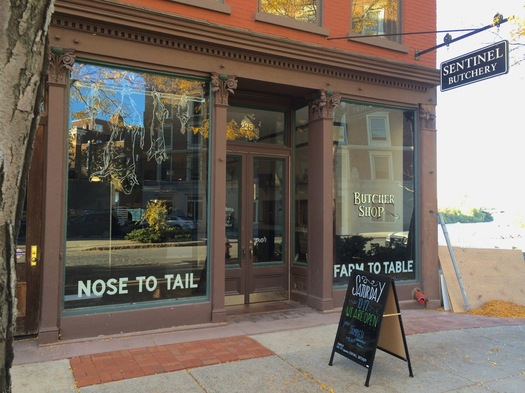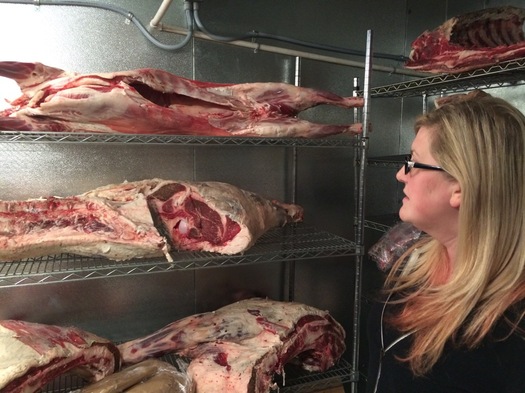Sentinel Butchery

The shop is on the street level of the building at 225 River Street, which once housed the Troy Sentinel. (The Sentinel was the newspaper that originally published "A Visit from St. Nicholas.)
A new whole-animal butcher shop -- Sentinel Butchery -- is opening on River Street near Monument Square in downtown Troy this Saturday.
Whole animal? That means Sentinel will be bringing in whole cows, pigs, lambs, and other animals and then making use of every part of the animal for a range of products.
We stopped by this week to talk with owner/butcher Emily Petersen for a few minutes and a get a quick look at the shop.
During our visit Thursday they were still getting things set up ahead of Saturday's (October 17) soft open. The shop's grand opening will be during the next Troy Night Out on October 30.
Here are a few bits from our conversation with Emily Petersen:

Emily Petersen
On nose-to-tail butchery and the products
Petersen says Sentinel will be sourcing humanely- and sustainably-raised animals from farms within a 150-mile radius of the Capital District.
"If you were to look at a map of the Capital District, it's kind of like a bullseye right in the middle of a ton of agriculture," she said to us. "We live in such an agriculturally dense area that sourcing product is not a problem at all."
Sentinel gets these animals either whole or in sides, and then butchers them for a range of products. Cuts of mean, of course. But also sausages and deli products. All with the goal of using as much of the animal as possible.
"We're not bringing in any additional items for the deli case. ... That's the joy of whole animal butchery, nose to tail, you use all the parts," Petersen said. "So, we're rendering lard, we're making bone stocks, we're making chicken salad, we're doing deli meats. Whatever we can do to use all the parts."
The goal is to be left with nothing but bones, which will then be composted.
"I really believe that these animals are dying for us so that we can consume them, they better have a damn good life and they better be slaughtered respectfully. And we better not waste."

In the walk-in fridge. That's a lamb on the top shelf, and parts of a cows on the lower shelves.
She's hoping you'll have questions
Sentinel's walk-in refrigerator is clearly visible from the front counter, and there's a window the lets you see the whole animal sides contained within. Petersen says she's hoping that will prompt conversations and questions.
"People can look at our carcasses, like or not, and talk to us about it," she said. "People can look at our carcasses and say where did you get it, what did it eat, what breed is it, how far away was it raised, why is this some fattier than the other one."
Petersen said the goal for these conversations is to help people gain an appreciation for the products and some of the issues involved.
"There's so many reasons to have that dialog. When you go out to eat and you see a hangar steak on the menu, there's only one hanger steak on every animal. So how many animals had to die in order to source nine hangar steaks? You encourage people to think about it more, to be more responsible about their consumption, to think about their purchasing habits. And what's really important about that is that their purchasing habits can change the system."
Petersen said they'll be happy to talk with people, and offer recommendations, about all sorts of different cuts and products. So, for example, if hangar steak isn't available, she says they can probably find another cut that will work for the customer.
And those conversations will probably end up touching on cost, too. Because products from humanely- and sustainably-raised animals do tend to cost a bit more.
"I'm really not a salesperson," Petersen said when asked about she'll address questions about cost. "We just tell them what's up. We tell them where we got it, what it ate, how it was raised, how it got there. We inform. ... And let them decide for themselves what choices they want to make with their money. I think what we're doing here is noble and good. I have no problem telling people whatever they want to know."

The shop's space is deep and looks out onto the river in the back. There's also space in the back where Petersen says they'll be offering classes.
On how she became butcher
Petersen described herself as a "kitchen pirate," having worked a wide range of restaurant jobs over 20 years. About five years ago she cooking and teaching food classes at a small school when she came across an opportunity at the Meat House in Wilton.
"They were like, do you know anyone who wants to learn how to cut meat and is a whole bunch of fun to work with? And I'm like, this girl right here! I'll do it! Of course I want to learn more things."
She picked up butchering skills there, and after moving over to Healthy Living Market she learned about nose-to-tail butchery. "I absolutely loved it."
Why Troy?
Petersen said she was drawn to Troy by the architecture, the history, and the walkability. And she also pointed to the popularity of the Troy Waterfront Farmers' Market as a sign that there's market for this sort of shop.
"I think we'll be successful here. I really do."
Find It
Sentinel Butchery
225 River Street
Troy, NY 12180
Hi there. Comments have been closed for this item. Still have something to say? Contact us.
Comments
I was a big fan of the proprietor when she was at Healthy Living. Very excited about this new development and the cool vintage location is just another reason to spend more time in Troy. Thanks!
... said Burnt My Fingers on Oct 16, 2015 at 6:21 PM | link
Great approach to food. Can't wait to check this place out.
... said emily on Oct 17, 2015 at 2:58 PM | link
I remember reading about this before and thinking it was awesome. I love the idea of putting the carcasses within view. I hope it's a success so I wish Emily all the luck.
... said Ryan H on Oct 18, 2015 at 10:50 PM | link
Well I am impressed with a female butcher! I will come by just to see the store!
... said Theresa on Nov 5, 2015 at 12:22 PM | link